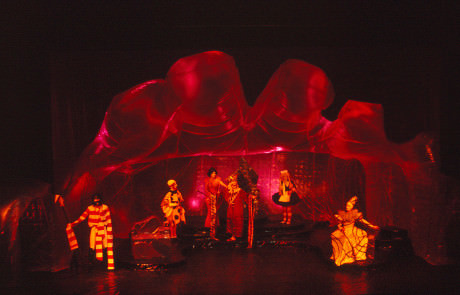Two-or three-mil plastic tube sheeting cut into a single thickness can be taped together with clear packing tape or two-sided carpet tape to make huge, bubble-like structures, some 200 set designers learned at the United States Institute of Theater Technology (USITT) Conference & Stage Expo.

A Helsinki designer described how he keeps them inflated with a battery-operated, 12-volt computer cooling fan powered by a rechargeable nickel–metal hydride (NiMH) battery.
You can use floor fans to blow them around and make them billow, said Sampo Pyhälä, a lecturer at Aalto University in Espoo, Finland, via videoconference.
“When I’m doing inflatables, I don’t think of them as pneumatic structures, I think of them more as sails,” said Pyhälä, who credited the New York street art of Joshua Allen Harris as one of his inspirations.
Lighting them from front, middle or back provides lots of different moods, said Tom Bliese, who did inflatables in the 1970s using a Teflon-coated tacking iron to melt the plastic because a clothes iron would have stuck to the plastic. Bliese, who retired in 2007 from Minnesota State University, Mankato, is active in USITT.
The structures can be filled with stage smoke for even more lighting effects.
“When you need to dissolve the walls, you just turn the fan off,” said Bliese.
Other fabrics that work for inflatables include space blankets, tarps, raincoat fabric, and rip-stop sailcloth, which is more durable but can be noisy when you move it, Pyhälä said.

He designed a reusable sailcloth dome and had it made at shop with a special sewing machine. At his theater, they just staple it to the floor to hold it in place so actors can lean against it and spring off of it. Children love to go inside of it for workshops, he said.
For the lighter fabrics, flat-felled (jeans style) seams should keep the air from leaking out.
Pyhälä has also created clear plastic puppets that the actors wear and manipulate from inside. If something gets a hole, they just tape it.
The presentation caused a lot of ideas to bubble up, and USITT members couldn’t wait to get back to their shops and experiment.
LINKS
Yvonne French To Report From U.S. Institute of Theater Technology’s 55th Annual Conference & Stage Expo on DCMetroTheaterArts.
Reporting From the United States Institute of Theater Technology (USITT) Conference & Stage Expo-Part 1: How to Set up a Rental Program for Costumes, Props, and Lighting Equipment.
Reporting From the United States Institute of Theater Technology (USITT) Conference & Stage Expo-Part 2: Immersive Production: Audience and Performance Blending.
Reporting From the United States Institute of Theater Technology (USITT) Conference & Stage Expo-Part 3: Free Software for Theaters on a Budget




